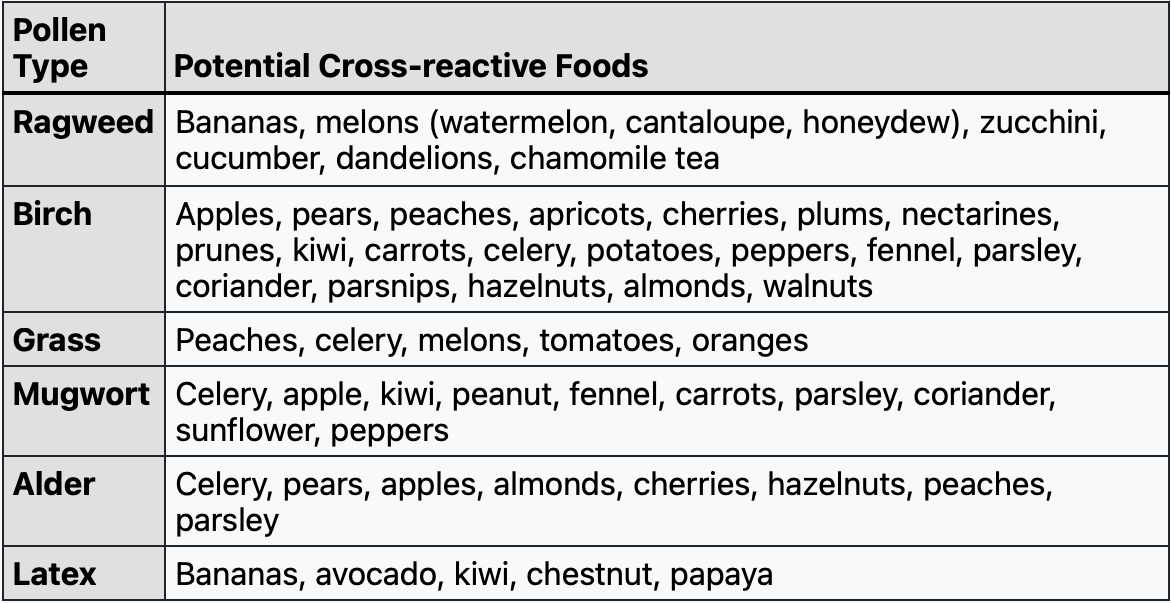What Is Oral Allergy Syndrome?

My favorite childhood snack was apples and peanut butter. I’d always enjoy a crunchy Granny Smith paired with creamy peanut butter before running off to swim practice. But everything changed one day when I was 11 years old.
I prepared my usual snack, but when I bit into the raw apple, my lips started to tingle. Swallowing, I felt my throat and ears becoming itchy. It wasn’t unbearable, but it was very irritating. I quickly chugged water and waited for the inflammation to subside, dropping my half-bit apple back onto the plate.
This reaction began occurring more frequently, but only when I ate carrots, kiwis, plums, or peaches. Concerned, my mom made an appointment with an allergist and told me to avoid eating any fruits with seeds.
The allergist decided to do a skin prick test on my back. This test is performed by adding a small sample of a potential allergen like pollen, trees, grass, or nuts. Then, the doctor makes a tiny scratch on the skin, allowing the substance to sink in and show a reaction, if any was present.
My back lit up like a Christmas tree, but the spot that shone the brightest was birch tree pollen. We already knew I was highly allergic to pollen, but the doctor explained that my body exhibited cross-reactivity to certain foods, all caused by my pollen allergy. She chalked it up as an inconvenience and encouraged me to stay away from foods that caused inflammation in my lips and mouth or my throat to swell.
There was no definitive diagnosis and, until a year ago, I simply avoided these foods. Eventually, I decided to do some research of my own and found out that this is a real condition called Oral Allergy Syndrome (OAS).
What Is Oral Allergy Syndrome?
The American Academy of Allergy, Asthma & Immunology (AAAAI) explains that OAS is a condition that affects individuals highly allergic to pollen. It occurs because the proteins found in certain raw foods are similar to those present in pollen. Consequently, these comparable proteins confuse the immune system, causing an allergic reaction. [1] This reaction is also known as cross-reactivity, the term my allergist used to describe this phenomenon several years back.
Each type of pollen contains its own group of foods that can trigger cross-reactivity. The following chart shows various allergies and the potential foods that may cause OAS reactions

Why Do People Develop Oral Allergy Syndrome?
OAS is commonly seen in people who struggle greatly with seasonal allergies. Research shows that it affects up to 50-75% of adults who are allergic to tree pollen. [1]
There isn’t a clear answer if OAS is genetic, based on current research. While seasonal allergies are more likely to develop if they run in the family, it’s not solely determined by a single gene. There is a “combination of many genetic variants that impact a person’s chances of developing seasonal allergies.” [3]
Looking back at it now, I remember my siblings questioning why they didn’t share my sensitivities to raw foods, given that they also had pollen allergies. They would sometimes go so far as to tell me I was just “being dramatic.”
In hindsight, it’s apparent that I have more severe allergies compared to my siblings. With the onset of spring each year, my symptoms intensify—itchy and swollen eyes, nasal congestion, and unbearable sneezing. On the other hand, my siblings would just get a minor sniffle.
Geographic location used to play a significant role in the severity of OAS. However, Naturopathic Doctor Erin Rhae Biller noted that because we export and import our produce way more frequently than we used to, OAS is no longer strictly a seasonal condition, unlike regular pollen allergies.
What to Do If You Have Oral Allergy Syndrome?
Dr. Biller explains that OAS is commonly misdiagnosed, or not diagnosed at all due to its mild presentation. Typically, the initial diagnosis for these symptoms is to stay away from problematic raw foods without further work-up and support.
In her practice, Dr. Biller has treated patients with OAS and explains that each protocol differs depending on the person. In general, she recommends that individuals with this condition should always keep natural mast cell stabilizers like quercetin, vitamin C, diamine oxidase enzymes (DAO), and over-the-counter antihistamines on hand.
RELATED: Histamine Intolerance and The Paleo Diet
In addition, she encourages her patients with Oral Allergy Syndrome to prioritize good gut health. An unhealthy and unbalanced gut microbiome can weaken the immune system and increase susceptibility to allergies. [4]
Although rare, OAS can lead to anaphylactic shock in cases of severe allergies. [1] If your allergies to pollen are debilitating, proceed with caution and seek guidance from an experienced healthcare professional.
Can I Have OAS and Still Eat Paleo?
Yes, you can! The easiest way to still enjoy all your favorite foods without triggering an OAS reaction is to cook your produce. Whether you bake, sauté, steam, or even microwave your food, applying heat can break down the proteins and prevent allergic reactions.
Just keep in mind that it’s important not to overcook your food. Excessive heat can cause fresh produce to lose nutrients.
One of my favorite snacks that I use to replace apples and peanut butter is sautéed apples with cinnamon. Simply dice an apple or two, sprinkle with cinnamon, and cook on the stove until softened. It’s quick, Paleo-friendly, and delicious!
If you suspect you may have OAS, consult an allergist or doctor. Educate yourself about the condition and be mindful of foods that may trigger a reaction. Make sure to have any necessary medications and tools on hand to support yourself.
Having Oral Allergy Syndrome doesn’t mean you have to restrict yourself from eating certain foods, it just means it’s time to get creative with cooking!
REFERENCES:
- Oral Allergy Syndrome Symptoms, Diagnosis & Treatment | AAAAI [Internet]. Aaaai.org. 2021. Available from: https://www.aaaai.org/Tools-for-the-Public/Conditions-Library/Allergies/Oral-allergy-syndrome-(OAS)
- Philadelphia TCH of. Oral Allergy Syndrome (OAS) [Internet]. www.chop.edu. 2014. Available from: https://www.chop.edu/conditions-diseases/oral-allergy-syndrome-oas
- Seasonal Allergies: Genetics and More – 23andMe [Internet]. www.23andme.com. Available from: https://www.23andme.com/topics/wellness/seasonal-allergies/
- B.Sc SR. Can you Treat a Food Allergy by Altering the Gut Microbiome? [Internet]. News-Medical. 2019 [cited 2024 Jun 13]. Available from: https://www.news-medical.net/health/Can-you-Treat-a-Food-Allergy-by-Altering-the-Gut-Microbiome.aspx#:~:text=Probiotics%20(substances%20that%20promote%20the
Isabella Mead
Isabella Mead is the Assistant Project Manager at The Paleo Diet and has experience in creating digital content for lifestyle and nutrition brands.
More About The Author




